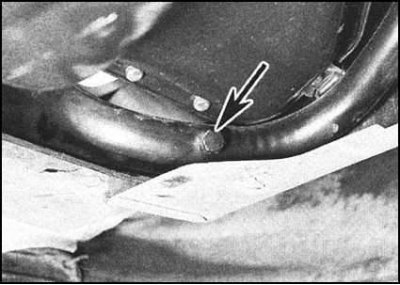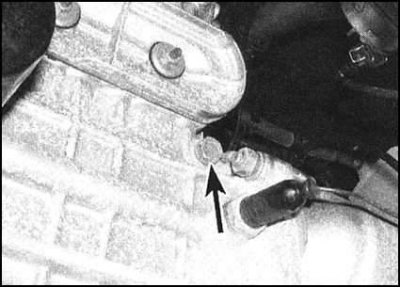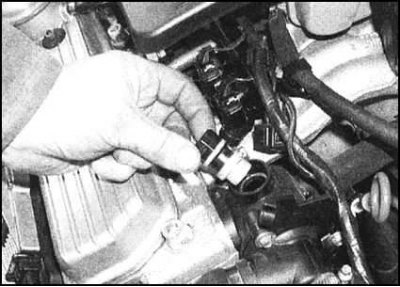Emptying the cooling system
Note. Wait until the engine has completely cooled down before proceeding with the procedure. Do not allow antifreeze to come into contact with eyes, exposed areas of the body and painted surfaces of body panels. Accidental splashes should be washed off immediately with plenty of water. Never leave antifreeze unattended in an unclosed container - its sweet smell can easily attract the attention of children and animals. Remember that getting antifreeze into the body can be fatal.
Models 1.3 l
1. After waiting for the engine to cool completely, firmly cock the parking brake, then jack up the front of the car and place it on props.

2. Remove the cap from the filler neck of the expansion tank (by turning the cap counterclockwise to the first stop, release the residual pressure in the system, then remove the cap completely). Install the receiving container under the drain plug screwed into the base of the metal tube passing under the crankshaft pulley.
3. Remove the drain plug and drain the coolant into the prepared container.

4. When fluid stops flowing, move a container under the drain plug at the front of the left end of the cylinder block, directly below the oil pressure switch. Unscrew the plug and drain the rest of the coolant into the container.
5. If the system is not emptied to replace the coolant, check the condition of the latter. Make sure that the drained fluid has been used for no more than three years. If everything is in order, the liquid can be reused, although the compilers of this Guide do not recommend such a practice. Prepare replacement drain plug sealing washers.
6. Clean the threads of the plugs and put new sealing washers on them. Lightly lubricate the plugs with fresh sealant, then screw them into place and tighten to the required torque.
Models 1.6 l
1. After waiting for the engine to cool completely, remove the cap from the filler neck of the expansion tank. Place a suitable drain pan under the lower radiator hose fitting..
2. Release the mounting clamp, disconnect the lower hose from the radiator and drain the coolant into the prepared container.
3. If the system is not emptied to replace the coolant, check the condition of the latter. Make sure that the drained fluid has been used for no more than two years. If everything is in order, the liquid can be reused, although the compilers of this Guide do not recommend such a practice.
4. When fluid stops flowing, reattach the hose and secure it with a hose clamp.
Flushing the cooling system
1. With a careless attitude to performing regular coolant changes, as well as in the case of severe antifreeze dilution as a result of frequent addition of plain water to the system, there is a gradual decrease in engine cooling efficiency due to the deposition of scale and corrosion products on the walls of the channels and galleries of the system. Restoring the original performance of the cooling system can be done by flushing it.
2. Flushing of the radiator is carried out separately from the engine cooling path in order to avoid the risk of contamination of the entire system.
Radiator
1. Disconnect the upper and lower large-section hoses from the radiator, as well as all other hoses related to the operation of the cooling system (see chapter Cooling, heating systems).
2. Insert a garden hose into the top hose inlet on the radiator and turn on the water supply. Continue rinsing until the water flowing out of the bottom pipe is completely clear.
3. If a clear exhaust stream cannot be achieved, use one of the many proprietary cleaners currently available to flush the radiator. In cases of particularly serious contamination, the radiator should be removed from the vehicle and subjected to backflow flushing.
Engine block
1. Remove the thermostat (see chapter Cooling, heating systems), then temporarily replace its cover.
2. After disconnecting the upper and lower hoses from the radiator, thread a garden hose through the first end and supply water. Continue rinsing until the stream coming out of the bottom hose is completely clean and clear.
3. After flushing, reinstall the thermostat and restore the original connection of the cooling system hoses (see chapter Cooling, heating systems).
Filling the cooling system
Before you start filling the cooling system, make sure that the condition and reliability of fastening on your fittings and pipes of all hoses related to its operation are in good condition. Do not forget that the system at any time of the year must be filled with the required composition of an antifreeze mixture with water. Otherwise, the rapid development of corrosion of the inner walls of the channels of the tract will begin.
Models 1.3 l
1. Make sure both drain plugs are tight.

2. Lower the vehicle to the ground and remove the coolant temperature sensor (CTS) from the top of the thermostat housing (see chapter Cooling, heating systems).
3. Remove the filler cap of the expansion tank and slowly start pouring the mixture of the required composition into the tank (see below), while watching the thermostat housing. When an air-bubble-free mixture begins to flow through the CTS installation hole, screw the sensor back into place.
4. After installing the CTS, continue to fill the mixture until its level in the expansion tank rises to the MAX mark on the translucent wall of the latter.
5. Replace the filler cap and tighten it securely.
6. Start the engine and warm it up to normal operating temperature (the cooling fan should turn on and off again).
7. Stop the engine, let it cool, then check the coolant level in the expansion tank again. Make adjustments if necessary.
Models 1.6 l
1. Make sure that the lower radiator hose is in good condition and securely attached to your fitting. Remove the filler cap of the expansion tank.
2. Remove the filler cap of the expansion tank and slowly pour the mixture of the required composition into the neck until its level in the expansion tank rises to the MAX mark on the translucent wall of the latter.
3. Replace the filler cap and tighten it securely.
4. Start the engine and warm it up to normal operating temperature (the cooling fan should turn on and off again).
5. Stop the engine, let it cool, then check the coolant level in the expansion tank again. Make adjustments if necessary.
Coolant layout
1. Coolant replacement must be done in accordance with the vehicle maintenance schedule (see above). Only the regularity of changing the antifreeze allows minimizing the corrosion of the cooling tract and ensuring the required frost resistance of the mixture in the winter season.
2. Use only ethylene glycol based antifreeze to mix, which is best suited for refilling automotive cooling systems with dissimilar metal paths. The requirements for the composition of the mixture, depending on the required level of protection, are given in Specifications.
3. Before filling, the system must be completely emptied, preferably flushed, and the condition and tightness of all hoses in the cooling path carefully checked.
4. When finished filling the system, attach a label to the neck of the expansion tank with data on the date of filling and the composition of the filled mixture. For all subsequent level adjustments, only the mixture of the same composition as indicated on the information label should be added to the system.
5. Never use antifreeze intended for use in the cooling system as a frost-resistant additive to windscreen washer fluid - this practice will inevitably lead to damage to the paintwork of body panels.
